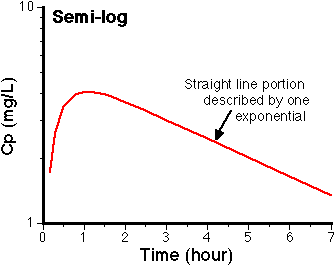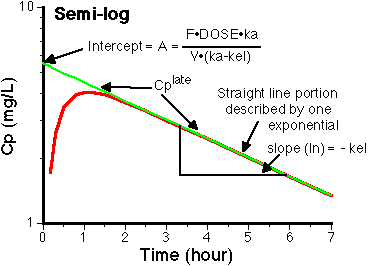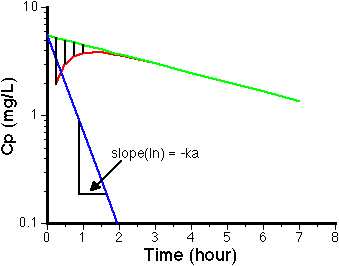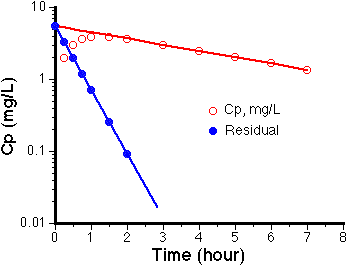




![]()
Equation IX-1 Cp versus Time after Oral Administration
this can be written as
Cp = A * e-kel * t - A * e-ka * t
where A = ![]()

Figure IX-1, Semi-log Plot of Cp versus Time Showing a Straight Line at Longer Time
Plasma Concentration versus Time Plots
The equation for this straight line portion can be obtained from the equation for Cp by setting the faster term (usually e-ka*t) to zero:

Figure IX-2, Semi-log Plot of Cp versus Time Showing Cplate, Slope, and Intercept
then
Cplate = A * e-kel * t
and plotting Cplate versus time gives a straight line on semi-log graph paper, with a slope (ln) = -kel and intercept = A.
Now

therefore

Plotting the ln (Residual) versus time should give another straight line graph with a slope (ln) equal to - ka and the same intercept as before, i.e. A
ln (Residual) = ln (A) - ka * t

Figure IX-3, Semi-log Graph of Cp versus Time Showing Residual Line
This is the method of residual or "feathering".
It can give quite accurate values of kel, ka, and V/F if :-
i) One rate constant is at least five times larger than the other
and
ii) Both absorption and elimination are first order processes.
Table IX-1: Example Data for the Method of Residuals
| Time (hr) | Plasma Concentration (mg/L) | Cp(late) (mg/L) | Residual [Col3 - Col2] (mg/L) |
| 0.25 | 1.91 | 5.23 | 3.32 |
| 0.5 | 2.98 | 4.98 | 2.00 |
| 0.75 | 3.54 | 4.73 | 1.19 |
| 1.0 | 3.80 | 4.50 | 0.70 |
| 1.5 | 3.84 | 4.07 | 0.23 |
| 2.0 | 3.62 | 3.69 | 0.07 |
| 3.0 | 3.04 | ||
| 4.0 | 2.49 | Residual | |
| 5.0 | 2.04 | Cplate | = 5.5 * e 2.05 * t |
| 6.0 | 1.67 | = 5.5 * e 0.2 * t | |
| 7.0 | 1.37 |

Figure IX-4, Plot of Cp and Residual versus Time
The objective of this panel is to illustrate the Method of Residuals for determining information about the drug absorption process.
First: Draw the Cplate line by changing the intercept (A(k1)) and slope (k1) values. Press the Cp(late) button to plot the line and calculate the residual values.
Second: Draw the Residual line by changing the intercept (A(k2)) and slope (k2) values. Press the Plot Residual button to plot the residual line.
By trial and error best fit lines can be drawn and the parameters determined.
Up to eleven (11) different data points can be entered instead of the example data provided. Leave fields empty if there are fewer than 11 data points in your data set.
Copyright 2002 David W.A. Bourne




